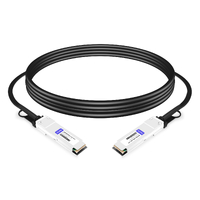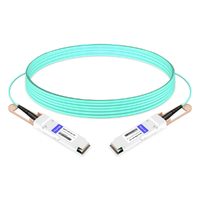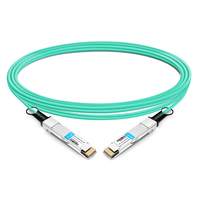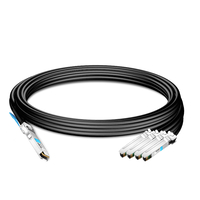The traffic in the data center has been growing. With the rapid development of Ethernet, the demand for bandwidth rate is higher and higher. The conventional low-speed rate can no longer meet the use of the data center. Low-speed rate upgrade is an inevitable trend. 100G optical communication transmission rate has become popular in the market and no longer has the technical advantage. Therefore, nowadays, everyone is focusing on developing 200G and even 400G transmission technologies. This article will introduce 200G DAC and AOC as well as 200G cabling solutions that can be applied to data centers.
Table of Contents
Toggle200G AOC vs. DAC: what are they?
What is 200G AOC – 200G active optical cable is a communication cable that requires external energy to convert electrical signals into optical signals or optical signals into electrical signals during communication. The optical transceivers at both ends of the cable provide photoelectric conversion as well as optical transmission functions, and the transmission rate reaches 200Gb/s. The AOC consists of two optical transceivers and a fiber optic patch cable, which has a long transmission distance, generally up to 100 meters.
What is 200G DAC – direct attach cable refers to the optical module installed on both ends of the high-speed patch cable, which is used to connect the switch to the router or server. DAC is widely used in storage area networks, data centers and high-performance computer connections. 200G DAC adopts silver-plated conductor and foamed insulating core wire, which has excellent attenuation performance and low delay performance so that the signal transmission is correct and can also improve the transmission speed. It is a short-distance connection solution instead of an optical module. The price is much cheaper than the same type of optical module and is widely welcomed in short-distance connection applications. The transmission distance of DAC is generally about 5 meters.
200G AOC vs. DAC: what’s the difference?
When we take AOC cable vs DAC, it is necessary to know that the biggest difference between AOC and DAC is that the transmission medium is different, that is, AOC cable is made of fiber optic material (insulation), which belongs to fiber-optic communication and is not subject to electromagnetic wave interference; while DAC cable is made of copper wire, which belongs to electrical communication and will be subject to electromagnetic interference. Moreover, the AOC contains a laser, while the DAC does not contain optical devices inside. As the price of fiber optic material is more expensive than copper cable, the cost price of the laser is also very high, so the price of the AOC is much higher than the DAC.
200G AOC and DAC cable: what are their transceiver form-factors?
The 200G AOC and DAC have mainly adopted two kinds of form-factors (packaging forms): QSFP56 and QSFP-DD.
- QSFP-56 form-factor: as an evolution of the 40G QSFP+ and 100G QSFP28, the QSFP56 (Quad 50 Gigabits Small Form-factor Pluggable) is designed specifically for 200G Ethernet. Compared with QSFP+ and QSFP28, the 200G QSFP56 form factor as a 200G QSFP supporting 4 x 50G channels can achieve higher network speeds. The most important change from QSFP+ and QSFP28 to QSFP56 is that QSFP56 changes from NRZ encoding to PAM4 encoding.
- QSFP-DD form-factor: QSFP-DD means “Quad Small Form Factor Pluggable Double-density”. The QSFP-DD can achieve two types of data rate forms: with NRZ modulation, the data rates of up to 25G x 8(channels) can be achieved for 200G network transmission; while with PAM4 modulation, the data rates can reach 50G x 4(channels), enabling 400G network transmission for high-performance computing data centers and cloud networks. QSFP-DD modules can support 400Gbps, while QSFP56 can only reach 200Gbps, so the QSFP56 package form is more commonly used in 200G optical transceivers and AOC/DAC cables.
200G AOC and DAC cable: how to use?
200G AOC application:
There are two kinds of 200G AOC, QSFP28-DD AOC and QSFP56 AOC, both with a wavelength of 850nm. The QSFP56 cable package has four transmit and receive ports, the transmission rate of each channel is up to 56Gbps, and the modulation mode is PAM4. The QSFP28-DD package has eight transmit and receive ports, the transmission rate of each channel is 28Gbps, and the modulation mode is NRZ. The 200G AOC is mainly used in 200G Ethernet with a transmission distance of 1-100m.
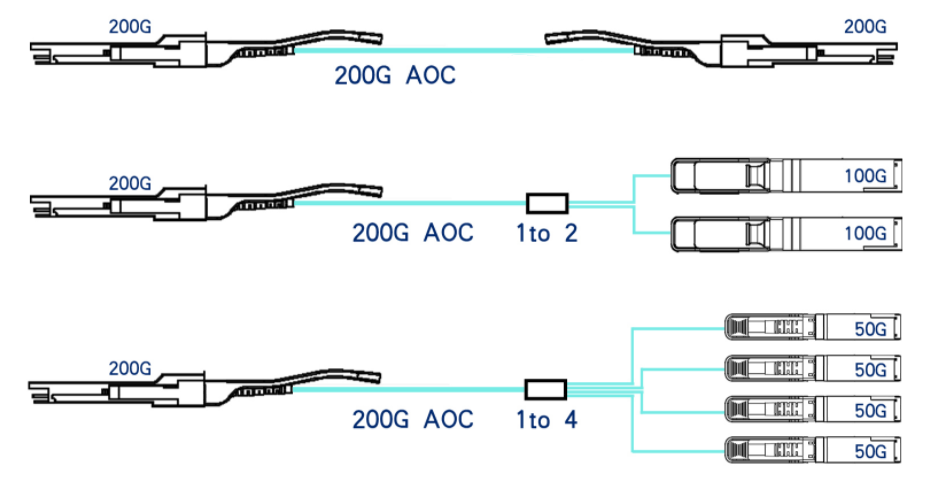
- 200G AOC to 2x100G AOC: one 200G optical module is connected at one end and two 100G optical modules are connected at the other end with a maximum transmission rate of 212.5Gbps.The power consumption of the 200G optical module is less than 4W, and that of the 100G optical module is less than 2.5W. This wiring method is mainly applied to the 200G to 2x100G Ethernet branch links in the data center.
- 200G AOC to 4x 50G AOC: Using 8-channel full-duplex active optical cable, one 200G optical module is connected to one end and four 50G modules are connected to the other end, with the maximum rate up to 206.25Gbps. The power consumption of the 200G transceiver is less than 4W, and the maximum power consumption of each 50G module is less than 1.5W. This wiring method is mainly applied to the data center 200G to 4x50G Ethernet branch links.
200G DAC application:
Similar to the 200G AOC, the 200G DAC has two packages: QSFP-DD DAC and QSFP56 DAC, both with a wavelength of 850nm. Different from 200G AOC, the power consumption of DAC is very small and can even be ignored, but its farthest transmission distance is only 5m.
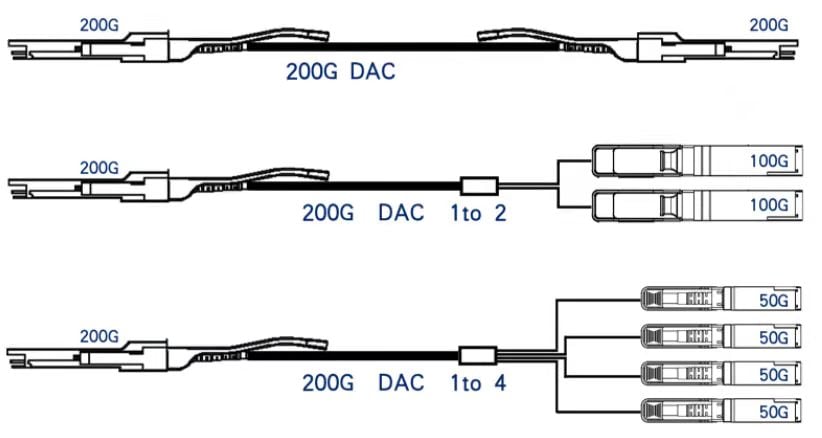
- 200G QSFP56 DAC to 2x100G QSFP28 DAC: one 200G QSFP56 optical module is connected at one end and two 100G QSFP28 optical modules are connected at the other end, with a transmission distance of 3 meters and a maximum transmission rate of 212.5Gbps. This cabling method is mainly used in 200G to 2x100G networks in the same rack in data centers. .
- 200G QSFP56 DAC to 4x50G SFP56 DAC: One 200G QSFP56 optical module is connected at one end and four SFP56 optical modules are connected at the other end, with a transmission distance of 3 meters. This 200G QSFP56 to 4xcabling method is mainly applied to 200G to 4x50G devices on the same rack.
As data centers continue to expand in size, transmission rates continue to get larger, so costs are trending straight up. Compared to 200G AOC, 200G DAC is smaller in power consumption because the connector module on top of the high-speed cable has no expensive optical lasers and other electronic components, which costs less. In summary, in the ultra-short distance of 200G data center transmission, DAC with price and power consumption advantage has received more attention.
Related Products:
-
 QSFP56-200G-PC1.5M 1.5m (5ft) 200G QSFP56 to QSFP56 PAM4 Passive Direct Attach Copper Twinax Cable
$60.00
QSFP56-200G-PC1.5M 1.5m (5ft) 200G QSFP56 to QSFP56 PAM4 Passive Direct Attach Copper Twinax Cable
$60.00
-
 QSFP56-200G-AOC-10M 10m (33ft) 200G QSFP56 to QSFP56 Active Optical Cable
$365.00
QSFP56-200G-AOC-10M 10m (33ft) 200G QSFP56 to QSFP56 Active Optical Cable
$365.00
-
 QSFP-DD-200G-AOC-10M 10m (33ft) 200G QSFP-DD to QSFP-DD Active Optical Cable
$595.00
QSFP-DD-200G-AOC-10M 10m (33ft) 200G QSFP-DD to QSFP-DD Active Optical Cable
$595.00
-
 QSFP56-4SFP56-PC2M 2m (7ft) 200G QSFP56 to Four 50G SFP56 PAM4 Passive Copper Direct Attach Breakout Cable
$80.00
QSFP56-4SFP56-PC2M 2m (7ft) 200G QSFP56 to Four 50G SFP56 PAM4 Passive Copper Direct Attach Breakout Cable
$80.00

